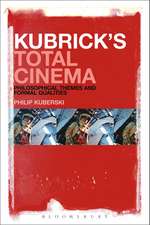Dark Energy: Hitchcock's Absolute Camera and the Physics of Cinematic Spacetime
Autor Philip J. Skerryen Limba Engleză Paperback – 28 aug 2013
| Toate formatele și edițiile | Preț | Express |
|---|---|---|
| Paperback (1) | 190.50 lei 43-57 zile | |
| Bloomsbury Publishing – 28 aug 2013 | 190.50 lei 43-57 zile | |
| Hardback (1) | 713.29 lei 43-57 zile | |
| Bloomsbury Publishing – 28 aug 2013 | 713.29 lei 43-57 zile |
Preț: 190.50 lei
Preț vechi: 221.60 lei
-14% Nou
Puncte Express: 286
Preț estimativ în valută:
36.45€ • 38.16$ • 30.34£
36.45€ • 38.16$ • 30.34£
Carte tipărită la comandă
Livrare economică 31 martie-14 aprilie
Preluare comenzi: 021 569.72.76
Specificații
ISBN-13: 9781441189455
ISBN-10: 1441189459
Pagini: 208
Dimensiuni: 152 x 229 x 18 mm
Greutate: 0.3 kg
Editura: Bloomsbury Publishing
Colecția Bloomsbury Academic
Locul publicării:New York, United States
ISBN-10: 1441189459
Pagini: 208
Dimensiuni: 152 x 229 x 18 mm
Greutate: 0.3 kg
Editura: Bloomsbury Publishing
Colecția Bloomsbury Academic
Locul publicării:New York, United States
Caracteristici
Includes remarkable interviews with top physicists and neuroscientists, exploring Hitchcock's greatest films
Notă biografică
Philip J. Skerry is Professor Emeritus at Lakeland Community College, Ohio, USA, and is the author of Psycho in the Shower: The History of Cinema's Most Famous Scene (2009), as well as numerous articles for scholarly journals. He lives with his wife Amy, a therapist, in Beachwood, Ohio, USA.
Cuprins
Introduction; 1: Science, Technology and Hitchcock; 2: Dark Matter, Dark Energy, and Physics; 3: Neurocinematics and Hitchcock's theory of suspense; 4: Three "Princes of Dark Energy": Uncle Charlie, Bruno, and Norman Bates; 5: Space and Place; 6: Vertigo and Psycho - The shower and the bell tower; Conclusion; Filmography; Bibliography; Index
Recenzii
In the end, Dark Energy has the considerable virtue of raising questions not only about the value of the particular scientific analogies he develops but of the value of argument by analogy in general.
Throughout the book, Skerry's enthusiasm is obvious, both for Hitchcock and for popular cosmology. Aficionados of Hitchcock will find new language with which to marvel, and those humanists with an interest in physics will find inviting ways to engage landmark theories of the last century.
To link Einstein with cinema and Hitchcock with modern physics is a daring experiment, and works on many levels. It is delightful for a physicist (and Hitchcock fan) to see terms like spacetime, antimatter, dark energy, black hole, entropy, etc. turn up as metaphors in a Hitchcock study. A thoroughly enjoyable read.
The 20th Century scientific theories of relativity, quantum mechanics and cosmology substantially changed the way we view the world. In interweaving these revolutions and their implications with the concurrent emergence of moving images as the predominant means of cultural expression, exemplified by their arguably greatest artist and innovator, Phil Skerry does much more than find a fresh angle on the depth in light and dark, the order and chaos in Hitchcock's visual storytelling. Always careful to emphasize that his approach implies the application of universal scientific truths only as metaphors to the most comprehensive (and, as Skerry argues, indeed spatiotemporal art form), he yet paints a bigger and most intriguing picture on how the 20th century zeitgeist was shaped through seeing the world differently, both in science and cinema. A most engrossing read, admirably aiming to bridge the regrettable modern gap between sciences and arts, via the genius of the likes of Einstein and Hitchcock, and finding nothing less than philosophy therein.
Throughout the book, Skerry's enthusiasm is obvious, both for Hitchcock and for popular cosmology. Aficionados of Hitchcock will find new language with which to marvel, and those humanists with an interest in physics will find inviting ways to engage landmark theories of the last century.
To link Einstein with cinema and Hitchcock with modern physics is a daring experiment, and works on many levels. It is delightful for a physicist (and Hitchcock fan) to see terms like spacetime, antimatter, dark energy, black hole, entropy, etc. turn up as metaphors in a Hitchcock study. A thoroughly enjoyable read.
The 20th Century scientific theories of relativity, quantum mechanics and cosmology substantially changed the way we view the world. In interweaving these revolutions and their implications with the concurrent emergence of moving images as the predominant means of cultural expression, exemplified by their arguably greatest artist and innovator, Phil Skerry does much more than find a fresh angle on the depth in light and dark, the order and chaos in Hitchcock's visual storytelling. Always careful to emphasize that his approach implies the application of universal scientific truths only as metaphors to the most comprehensive (and, as Skerry argues, indeed spatiotemporal art form), he yet paints a bigger and most intriguing picture on how the 20th century zeitgeist was shaped through seeing the world differently, both in science and cinema. A most engrossing read, admirably aiming to bridge the regrettable modern gap between sciences and arts, via the genius of the likes of Einstein and Hitchcock, and finding nothing less than philosophy therein.


















